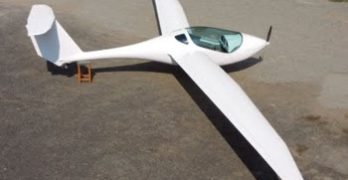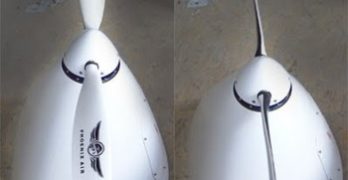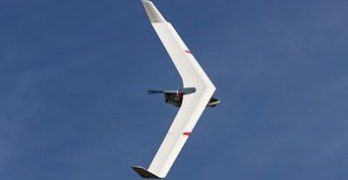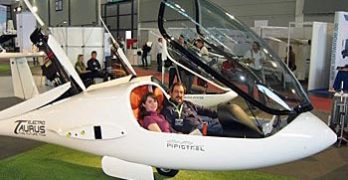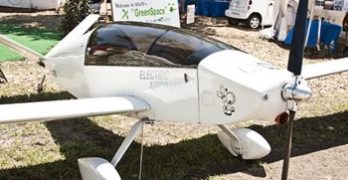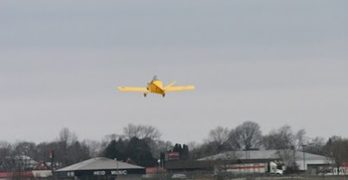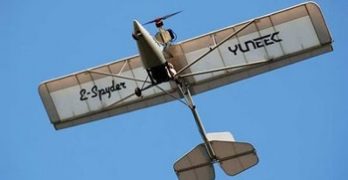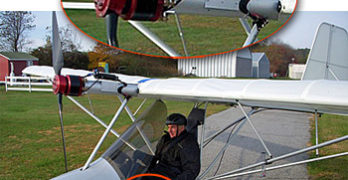Picking up my electric aircraft coverage again with an email from Phoenix Air USA kingpin Jim Lee with the latest updates on the PhoEnix electric motorglider NASA/CAFE race entry, which just came out of the paint shop and has all its pretty parts put together…and a beautimous bird she is indeed.”We put the PhoEnix together,” Jim tells me, “my last day in Czech so we could finally see what it looks like. Man am I excited now! I can’t believe that I will be the one to fly such an amazing ship.” Color me green with envy. *** Jim’s deep and broad soaring background should stand him in good stead tweaking every last ounce of performance from the gorgeous, one-off soaring bird. *** He’s also got a few more details on his Phoenix blog. Here are some highlights: *** Conceived for the NASA CAFE Green Flight Challenge… “A race that offers big bucks for the winner ($1.65 million total), but with a bar set so high that it is unlikely that anyone will win it.
Search Results for : Electric
Not finding exactly what you expected? Try our advanced search option.
Select a manufacturer to go straight to all our content about that manufacturer.
Select an aircraft model to go straight to all our content about that model.
“Spy Network” Report: Twin Electric Sailplane
I heard again today from Jim Lee who’s still overseas helping prep the PhoEnix electric motorglider for July’s big, $1.65 million CAFE Green Flight Challenge (GFC) fuel-efficient flight competition in Santa Rosa, CA. *** Jim sent along photos of the electric nosecone with integrated feathering prop/spinner assembly. First test flights of the PhoEnix are planned in a couple weeks. *** BTW, the enhanced streamlining afforded by the much smaller e-motor boots the lovely creature’s performance from L/D 32:1 to 36:1 — a 12.5% increase! That’s great for soaring and also means less power required to sustain flight, the Big Picture for endurance at this stage of electric aviation. *** The GFC PhoEnix entry will be powered by a 44 kW motor and controller developed in house by Phoenix Air. *** Lipo (lithium polymer) batteries, popularized by the RC model industry for their light weight and high storage capacity, will hold the electric “gas”.
PhoEnix: “E” as in Electric
Scoop time!
I’ve been having so much fun lately writing the electric flight article (now rescheduled to Aug. issue of Plane & Pilot) that it’s bringing electrifying news from the universe to my email inbox.
Jim Lee, that hard working, happy-flying distributor for the Phoenix motorglider I was gobsmacked with at Sebring, told me today about the PhoEnix all-electric version of the Rotax-powered motorglider that is selling like hotcakes here and abroad.
Here’s some of what he had to say: “Reporting from the Czech Republic where I am spending 2 weeks assisting in the production of our new electric PhoEnix. The weather has been great… soaring 5.5 hours in the last two days… I see that your blog has sort of turned into an electric blog lately, so that gave me the idea to report to you first on our electric project. Orders for the Rotax Phoenix are pouring in, so we had better stop flying and start working.”
Oh, for that challenge: to fly, or handle orders for your aircraft!
Electric Flight: More Thoughts
Yesterday a reader commented on my electric flight post, specifically about the LZ FES, a pretty sexy add-on that just won the Lindbergh LEAP prize for best new electric propulsion system. He wondered whether electric flight for now required light weight motorgliders or whether heavier, 15M plus sailplanes/motorgliders would be workable for electric power. *** My answer began to get too lengthy to stick in comments so I’m posting it here, and thanks Thomas for your enthusiasm. *** I talked over this very subject this week with Randall Fishman, the award-winning electric flight pioneer. His take on where we’re at right now is in my Profiles in Vision column, coming in the July issue of P&P. *** Randall’s whole trip is to get people up in the air with electric power right now, and not for 150,000 clams either. To summarize his own one-man research and development plan, it’s all about lightweight motorgliders.
LEAP Awards Electric Aviation Prizes
Eric Lindbergh, grandson of Charles A. Lindbergh, awarded the LEAP Prize to Pipistrel’s Ivo Boscarol at the just-finished Aero General Aviation convention in Friedrichshafen, Germany. *** The 3rd annual e-Flight gathering took place there also, and Lindbergh’s Best Electric Aircraft award went to Pipistrel’s Taurus Electro. *** There were some notable challengers in the category and three finalists: the Taurus, the Electric Cri-Cri (power by Electravia), and Eric Raymond’s Sunseeker II solar airplane. *** Also awarded was the Best Electric Propulsion. The two finalists were the LZ Design FES (Front Engine Sustainer) system and the Rapid 200 Fuel Cell propulsion system from Polytechnic Torino. *** The LZ FES was the winner. *** The LEAP 2011 Outstanding Achievement Award went to Bertrand Piccard, Andre Borschberg and the Solar Impulse Team for its electric around-the-world project airplane. *** A romantic, and apt, spin on the awards is linking today’s electric pioneers to Lucky Lindy’s amazing transatlantic flight in 1927, which pretty much singlehandedly changed the global perception of aviation from a daredevil hobby or foolhardy mail delivery system to the common transportation, recreational and warfare tool it has become.
Electric Motorglider For Sale
Catching up on some particulars with Randall Fishman of ElectraFlyer after our chat at Sun n Fun, he told me he’s selling his prototype C model for $49,000.
Here’s what he had to say about it and other aspects of his electric powered aircraft pioneering efforts: “We have sold trikes since 2007. Most of our sales are propulsion kits, batteries and chargers for people either building something new or converting to electric. The first two of the new motors are in my shop now and we will be mounting them for testing.
“The C is a one off conversion of a plane I already owned (a Moni kit motorglider). I want to sell it now to help finance the new projects. It is really the first successful electric airplane other than some exotic million dollar science projects such as the solar planes. I hope there is a collector out there.
Electric Waiex Makes Maiden Flight
Followers of these exciting pioneering days of electric-powered aircraft will be happy to know the all-electric Waiex just made its maiden flight at Wittman Field, home of Oshkosh Airventure — and Sonex Aircraft. *** John Monnett, head honcho of Sonex, which built the proof-of-concept version of its Waiex kit aircraft as part of its E-Flight Initiative, took the controls for the flight, tasked primarily with breaking out of ground effect to analyze in-flight system performance. *** After landing, John said, “Whew. It’s different! Lot of power.” *** The program started four years ago, and involves the airplane and Sonex’s development of its own proprietary motor, battery and speed controller — all vital parts of electric propulsion technology.Jeremy Monnett, John’s son and CEO/General Manager of Sonex, said the company will test the aircraft over the next several months and has already begun design work on the fourth version of the motor and twelfth version of the motor controller, which will be integrated into the current Waiex test bed.
Electric LSA as Primary Trainers?
Electric LSA as Primary Trainers?
One of the interesting speculations in a recent Wired magazine article on the E-Spyder electric ultralight being developed by Flight Design USA‘s (and FlightStar Aircraft‘s) Tom Peghiny invokes turning the lemony limited range of current early electric aircraft into the lemonade of broadly-applied commercial use — specifically in flight schools. *** The first production E-Spyder, soon to be sold for around $30K, will have no more than 30 minutes of range. Yuneec’s two-seat E430, now scheduled for 2012 debut, aims for a 2 hour flight endurance. *** But two hours clearly is more than enough for the typical local flight lesson. And with spare — and charged — battery pack modules ready to go to quick-swap out of electrical “fuel tanks”, flight schools could run training ops as easily as their current gas engined counterparts. *** No distracting engine noise and frame vibration; no lean/enrich fuel settings; no starter motors or smelly exhausts to deal with.
Whirring into the Air on Electricity
You’re probably aware of the auto industry’s billion-dollar bet on electric cars. Skeptics are plentiful. Same for airplanes. Despite doubts, even Cessna and Bye Energy are teaming up on an electric 172. Other LSA electric projects are also underway and it’s all good in my mind. *** Most e-powered aircraft remain in the future. Yet here today is the E-Spyder. You can place an order that’ll set you back less than $30,000. Plus it’s a true Part 103 ultralight meaning you don’t need no stinkin’ government license to fly it. *** I wish I lived closer to Woodstock Connecticut where co-developer Tom Peghiny is flying Yuneec’s E-Spyder along with a few trusted friends. The one they’re flying has longer wings and a battery-hiding compartment (top photo, circled). Tom wrote, “We have been flying a lot since finishing the plane in mid September.” So far Tom and team have taken 15 flights on the upgraded version. This prototype (#3) has many changes over the original that was shown at Airventure in 2009.
- « Previous Page
- 1
- …
- 5
- 6
- 7
- 8
- 9
- …
- 67
- Next Page »


